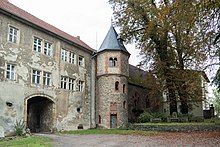Alvensleben's libraries
The Alvensleben libraries are several historical book collections that represent part of the cultural heritage of the von Alvensleben family .
- The Alvensleben feudal library was instituted by Joachim I von Alvensleben in the 16th century and housed there after the restoration of Hundisburg Castle. It comprises around 4700 volumes.
- The chapel library with approx. 2200 volumes, which belonged jointly to the Erxleben I and Erxleben II houses and was divided between the two houses in 1936. The part that was allocated to Erxleben II was largely saved in 1945 together with the feudal library shortly before the Russian occupation and is now back in Hundisburg. A good half of the part attributable to Erxleben I has been lost, only around 450 volumes - mainly from the University and State Library of Saxony-Anhalt in Halle - could be restituted and put up again in Hundisburg.
- The allodial or Fideikommisbibliothek Erxleben I with around 2000 books is largely lost. This included a valuable collection of children's books in German, French and English, illuminated with copperplate engravings.
- The allodial or Fideikommisbibliothek Erxleben II with around 7000 books, mostly from the 18th and 19th centuries, of which around 2000 have now been restored.

The library of Joachim I von Alvensleben , who had obliged his descendants “to preserve, increase and never share”, was originally located in Erxleben Castle , but became public as early as 1610, a good 22 years after the death of its founder Brought to Stendal for use and was accessible there for around a hundred years. In 1709 the minister Johann Friedrich II. Von Alvensleben brought it to his newly built Hundisburg Castle , where it was housed in the north tower. When Hundisburg had to be sold in 1811, the library came back to Erxleben. A new library building was built there from 1899–1903, in which the collection and other books remained until 1945. In June 1945 around 5,600 volumes from the old library together with other cultural assets, such as the choir stalls of Magdeburg Cathedral, were brought to safety in Pattensen near Hanover shortly before the occupation by the Red Army . They were first given to the Loccum Monastery and, since 1976, to the Herzog August Library in Wolfenbüttel . In February 2012 the collection was returned to the region in which it was created and placed again in Schloss Hundisburg, where - supplemented by around 500 restituted books - it will continue to be accessible to the public as a branch of the University and State Library of Saxony-Anhalt in Halle from September 2012 .
The current holdings still include around 6,000 works, most of them historically significant, and are considered one of the most important private libraries of the Renaissance period. 60 percent of the holdings are from the time of Joachim (1514–1588), 30 percent come from the 17th century and 10 percent from the early 18th century. The library mainly contains Theologica, Philosophica, Philologica, Juridica, Historica, Medica, Astronomica and Mathematica as well as funeral sermons. Edited volumes belong to all disciplines.
The collection was never part of the Stendal City Library or its predecessor libraries, but was open to the public in Stendal from 1610 to 1811.
Web links
- Alvensleben library on the website of the University and State Library of Saxony-Anhalt
- Alvensleben library on the website of the family von Alvensleben eV
literature
- Udo Gebhard Ferdinand von Alvensleben : Origin, history, purpose and purpose of the Alvensleben family or feudal library in Erxleben . Copy of a handwritten preface to the library catalog (1872).
- Albrecht von Alvensleben-Schönborn : Lecture . In: Family festival at Erxleben Castle, black line for the inauguration of the library rooms on May 4, 1905 . Eyraud, Neuhaldensleben 1906, pp. 5-9.
- Franz Zimmermann : The library of the Lords of Alvensleben in Erxleben . In: Monday sheet. Knowledge Supplement to the Magdeburg newspaper . Vol. 77, No. 15 of April 15, 1935, pp. 113-115.
- Albrecht von Alvensleben, Hans Friedrich von Ehrenkrook: The funeral sermons in the von Alvensleben's feudal library at Erxleben II Castle . Archive for kin research 1935, pp. 280-282, 317-322, 403-408.
- August Wilhelm Kazmeier: A previously unknown bookseller advertisement and other early prints by Lukas Brandis from an old castle library . Zentralblatt für Bibliothekswesen 57 (1940), pp. 292-299.
- August Wilhelm Kazmeier: The printer of the Melusine and Heinrich Koster. A contribution to Lübeck's earliest art of printing and binding . In: Gutenberg-Jahrbuch , 1941, pp. 98–117.
- August Wilhelm Kazmeier: Two Donat Fragments. Previously unpublished find report on GW 8840/10 and 8882/10 . In: Gutenberg-Jahrbuch , 1964, pp. 61–65.
- Max Joseph Husung : Roll and plate stamps on bindings from the 16th century in the library of Count Friedrich Johann von Alvensleben zu Erxleben . In: Archives for bookbinding. Zeitschrift für Einbandkunst 43 (1943), pp. 45–50; 44 (1944), pp. 1-6, 11-16, 23-26.
- Werner Arnold : Nobility education in Central Germany: Joachim von Alvensleben and his library . In: Libraries and Books in the Age of the Renaissance . Wolfenbütteler Abhandlungen zur Renaissanceforschung 16. Wiesbaden 1997, pp. 167–194 - also published in: Berthold Heinecke, Hartmut Hecht (Ed.): At the center of the messages occurring between Hanover and Berlin. Gottfried Wilhelm Leibniz in Hundisburg . Contributions to the conference in Hundisburg on September 18, 2004, pp. 75–95.
- Ulrich Hauer : The library of the von Alvensleben family . In: Katrin Dziekan and Ute Pott (eds.): Reading worlds - historical libraries. Book collections of the 18th century in museums and libraries in Saxony-Anhalt . Halle 2011, pp. 172–192.
Individual evidence
- ↑ Culture report. Quarterly issues of the Central German Cultural Council, issue 70, June 2012, p. 3
- ↑ Herzog August Library Wolfenbüttel
